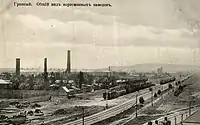
Grozny oil field was one of the largest oil-industrial regions in the territory of the Russian Empire and then the USSR.
Oil seeps to the surface of the earth in the North Caucasus were noticed long before the beginning of the industrial development of oil fields on the slopes of the relatively low Tersky and Sunzhensky ridges. Since ancient times, local residents have collected oil here, which was used for household needs, medical and military purposes. They lubricated the axes of the supply with oil, treated people and animals, burned it in lamps, etc. In the 19th century, a whole group of deposits was found on the Grozny Range. Oil was extracted from wells no deeper than two arshins, from which it was simply scooped out with a bucket. Since 1811, oil wells have been farmed out. Such a farmer was originally the Mozdok Regiment, and since 1838, all oil sources have become the property of the Caucasian line troops. This army rented oil wells to merchant farmers, wealthy Cossacks, and other entrepreneurs. From 1833 to 1860, about 140 thousand pounds of oil were mastered in this way.[1]
Oil production, which at that time was carried out by artisanal methods, peaked in 1885 at 77,000 poods (1 pood = 16.3 kg). Scientists have undertaken a serious study of Grozny oil. Among them was the outstanding Russian chemist, D. I. Mendeleev. The industrial development of the Grozny oil region began. In 1892, 450,000 barrels of oil were produced. Grozny fisheries occupied second place in terms of productivity in the country.[2]
Description

The Grozny region of oil and gas fields is part of the North Caucasian oil and gas region of Russia. Oil-bearing areas are concentrated in the areas of the Sunzha and Tersky ridges and the Black Mountains. The Grozny region, along with the Baku region, was one of the very first oil-producing regions of the USSR. The beginning of industrial oil production was laid back in 1893, when the first fountain of oil gushed from a depth of more than 130 meters in the Starogroznensky district. Over the century-long history of the industry, 420 million tons of oil have been extracted from the bowels of the earth.[3][4]
The largest deposits are: Novogroznenskoye (Oktyabrskoye) and Starogroznenskoye (with the oil-bearing areas of Tashkala and Salt Balka). Oil fields approach anticlinal folds, usually overturned and complicated by ruptures. The main oil deposits belong to the sandstones of the productive strata of the Karagan and Chokrak horizons of the Middle Miocene. Oil is paraffinic, with a high content of light fractions (in particular, gasoline). Geological exploration of the Grozny oil-bearing region began in the second half of the 19th century, and industrial production began in the 1890s. At the end of the 19th century, 7 English companies with a capital of 11 million rubles established themselves in the Grozny oil-industrial region, relegating the French Rothschilds, who had previously occupied a leading position among foreign firms, to the background. In 1913, the Novogroznenskoye field was discovered. The main owners of the Grozny oil fields were the world's largest oil companies and concerns: Nobel, Shell, Oil, Tweedy-Andreis, etc. By 1914, in the oil industry on the territory of the Grozny oil-bearing region, in percentage terms: English 36%, Russian 27%, French 18%, Belgian 10%, Dutch 9%. During the years of Soviet power, the largest fields were put into operation: in 1934, Malgobekneft; in 1937, Goragorskoye; in 1941, Oysungur; and in 1945, Tashkala. Checheno-Ingushetia was the second oil center of the USSR after Azerbaijan (the average oil production by the beginning of the Second World War was from 3 to 4 million tons annually, and its explored reserves amounted to 1.5 billion).[5][6]
Gallery
 Grozny. View of the refineries and the railway station. 1910-1915
Grozny. View of the refineries and the railway station. 1910-1915 Grozny. General view of the kerosene plants. 1910s
Grozny. General view of the kerosene plants. 1910s
See also
References
- ↑ Birlant Nunaeva. My city is Grozny.
- ↑ K.I. Jafarov, A.K. Jafarov. 110 years of the Grozny oil industry: pages of history
- ↑ Independent oil review well — Oil in the world — «Chechen Republic: oil perspective»
- ↑ Pritula A.F. Grozny oil and Terek mining industry before nationalization. — M.; L., 1925.
- ↑ Akhmadova Kh. Kh., Musaeva M. A., Syrkin A. M., Makhmudova L. Sh., Takaeva M. A., The role of Russian and foreign capital in the development of the Grozny oil industry in 1890—1900.
- ↑ Brief geographical encyclopedia, Volume 1 / Ch.ed. Grigoriev A.A. M.: Soviet Encyclopedia — 1960, p. 564
Further reading
- Казаков А. И. (составитель) (1984). Город Грозный (15000 экз ed.). Гр.: Чечено-Ингушское книжное издательство.
- Притула А. Ф. (1925). Грозненская нефтяная и терская горная промышленность перед национализацией (1200 экз ed.). М.: Издание совета нефтяной промышленности.
- Весь Грозный и его окрестности: нефтяные промысла, курорт Горячеводск, курорт Серноводск (Д. А. Бабкова и А. И. Максимова ed.). Владикавказ: Электроп. Сергея Казарина. Под ред. Дм. Приволжского. 1914.
- Керимов И. А. и др. (2010). Геология и перспективы нефтегазоносности Чечни и Ингушетии (300 экз ed.). Гр.: ООО «Пилигрим». ISBN 978-5-91857-007-4.
- Притула А. Ф. Направление грозненского трубопровода и проекты его осуществления// Нефтяной бюллетень. — 1924. — No. 20.
- «Народоубийство в СССР: Убийство чеченского народа» — Мюнхен: Свободный Кавказ, 1952. — 69 c. — LCCN 68-040208
- Переиздание: «Убийство чечено-ингушского народа : Народоубийство в СССР» / Авторханов, Абдурахман Геназович-Александр Уралов (псевд.). — М: СП «Вся Москва», 1991. — 79, [2] с.; 20 см — ISBN 5-7110-0131-0.
- Добыча, переработка и исследование грозненской нефти в течение XIX — начало XX веков: монография / Х. Х. Ахмадова, М. А. Мусаева, А. М. Сыркин, Л. Ш. Махмудова, М. А. Такаева. — М.: Издательский дом Академии Естествознания, 2018. — 146 с. — 500 экз. — ISBN 978-5-91327-519-6.
- Григорьев А. А. Грозненский нефтяной район. Библиотека по географии.. краткая географическая энциклопедия, Том 1/Гл.ред. Григорьев А. А. М.:Советская энциклопедия — 1960, с. 564.